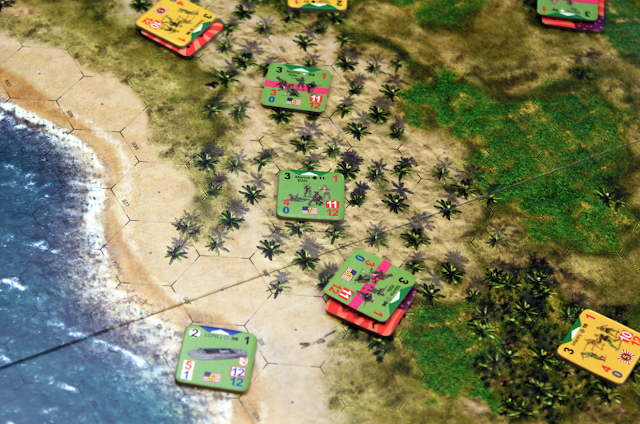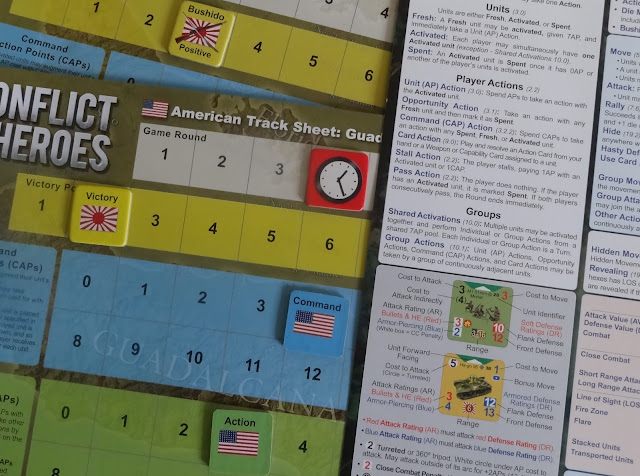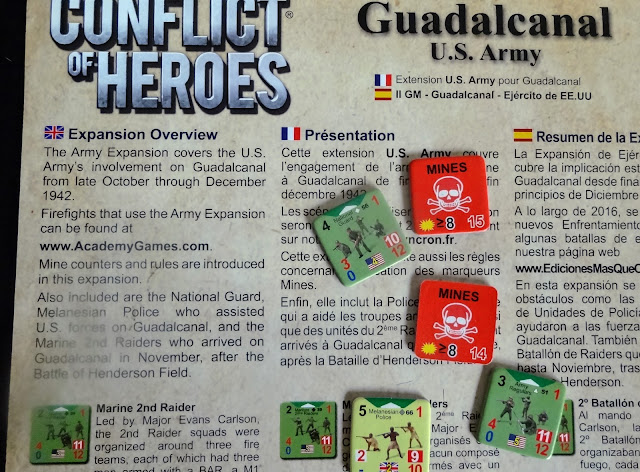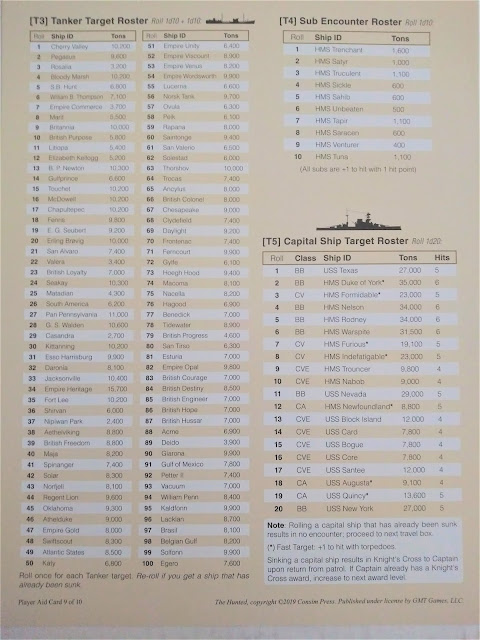Overview
Conflict of Heroes: Guadalcanal was released in 2016 and is a squad-level,
tactical, hex and counter wargame. The Pacific Theatre of WWII holds a massive interest for me; despite my
living a figurative stones throw away from a lot of European WWII history. I am just in awe of the willing and
persistent sacrifice of both sides' combatants in a theatre that arguably
comprises the most bloody battles of WWII, Guadalcanal included. To say I was eager to review this game would be an understatement.
CoH:Guadalcanal focuses on the landings of the US Marines
onto the strategically important island of Guadalcanal and their subsequent
defence of the island and the vital airfield it offered to the Americans. This
action was at an early part of the Pacific War and is the first major allied offensive
against the Japanese who had been enjoying a string of victories as they
successfully invaded large chunks of real-estate in the South Pacific. I think it is useful for wargamers to understand the context in which any wargame is set and Academy Games have done a fantastic job setting-the-scene with a rule-book littered with designers notes and a three-page [campaign introduction]
that describe the strategic situation in which the players cardboard chits find
themselves.
 |
| Inside pages of rules and firefight book |
Gameplay
The game contains 12 firefights that play out the Marines defence of Guadalcanal against increasing numbers of Japanese forces.
The rule-book follows a programmed instruction method whereby players can read a
scant 9-and-a-bit-pages of rules before playing the first fire-fight (I
estimate that includes about 3 pages of examples and designers notes).
If you are an experienced wargamer, there are lots of similarities to other rule sets that will enable you to be up and playing very quickly, for example the Line of Sight and blind hex rules were very familiar and the overall terrain defensive modifiers are almost exactly the same as in other tactical-level wargames. These similarities are all wrapped in a combat system and turn structure that is completely unique, as far as I can tell, to the Conflict of Heroes line. The rules are also very well written and littered with a plethora of gameplay examples, it was a rare case where I had to look up a rule in which either it wasn’t immediately obvious from reading the rule or there wasn’t a relevant example to clarify the situation.
 |
| The first firefight |
Many good wargames reduce the IGOUGO problem by allowing an opponent to
Op Fire a moving stack or react to a move. CoH completely removes the IGOUGO
problem by alternating turns between players after every action is resolved.
The players only have 1 active unit at a time and 7 action points to spend on
that unit. The different actions cost a different number of action points and
when they are all spent, or if a player decides to activate another unit, that
counter is flipped to its 'spent' side. I really like this mechanism, it not
only indicates which units have already moved (my memory is very grateful) but
it removes any down time as you're only waiting for your opponent to make one
action e.g. a single unit moves one hex, before it rolls back to you. It also
means that as a player you're constantly having to evaluate whether your plans
remains sensible in light of your opponents last move or whether you should
adapt and activate a different unit, potentially losing Action Points.
All combat actions are quickly resolved by 2d6 modified by
unit attributes and the environment. The combat system is very intuitive, easy
to teach and if you're reading the rules by yourself, to learn. In essence you
add the firing units Attack Rating to 2d6 for your Attack Total. The Defender
adds any defensive modifiers from terrain to their Defence Rating. If the
attack value is greater than or equal to the defence value that unit is hit.
When a unit is hit another counter is placed face-down underneath which will
affect the units attributes and available actions. Two hits on the same unit eliminates
that unit. That's essentially it, although the action cards do add a nice layer of immersion.
 |
| The Action Cards |
The combat system is really quick and I didn't feel that it
was missing any crunch that we wargamers often yearn for. Attacking units use
one of two Attack Ratings printed on the counter dependent on whether their
target is a vehicle or personnel target. Defending units use one of two Defence
Ratings printed on the counter depending on which direction the attack is
coming from. In my experience
the direction individual units are facing is rarely modelled in wargames. Here, it is
seamlessly integrated into the combat and adds a level of tactical
consideration that I enjoyed e.g. should I activate this unit to turn and face
the encroaching enemy and receive the best defence possible thereby losing my
opportunity to attack with this other unit?
In overall terms of complexity this game is a little lighter
(and maybe more fun?) than GMT's Combat Commander series, which does suffer a
little with the IGOUGO problem. To stretch a bad analogy, if Advanced Squad
Leader is like completing and filing your own tax return (some masochists enjoy
it), Combat Commander would be like planning a monthly budget and realising
that you've actually got money left over (always nice to see), CoH:Guadalcanal
is like getting lucky after taking a punt at the betting shop (Let’s try that
again…). In my face to face plays of this I felt like I was having more fun for
a very similar level of enjoyment when compared to Combat Commander
series. If I did score games this game
would get top marks for fun and also for the amount of [historical backgrounds]
provided for each firefight. Academy Games have a reputation of releasing fun,
educational games and in that they've excelled themselves with CoH:Guadalcanal.
 |
| Fully loaded box |
One of my biggest dislike of many wargames, and I still play
them so it's not that big, is that in a lot of them the players have a perfect
knowledge i.e. the players can see all terrain and unit attributes and plan
accordingly, there is no fog of war. This is not necessarily a bad thing in a
wargame as long as the scenario is balanced, you're then playing against your
opponents tactics and trying to mitigate the randomness of the dice. However,
there is an extra level of immersion when you're fighting with fog of war
modelled. CoH does a good job of this as your opponents do not know what
effects their hits are having on your units and players can attempt hidden
movement, or even setup hidden, in cover terrain. This is a very important
tactic of the Japanese player and when it works it is, depending on your
perspective, either a beautiful moment of bravery or an excruciating loss.
Unfortunately, you're not provided with anyway to mark hidden movements but the rule-book recommends to print out maps from the Academy Games website to record
hidden units on. You can also download all of the firefights and rule-books for
the entire CoH system and expansions which I think is a good sign for the level
of support that this game continues to receive.
 |
| Firefight 4 - Japanese have held out so far... |
There are very clear differences between WWII-era military forces of America and Japan, their moral, funding, equipment, ethos etc. feel
different in reality and should feel different when playing them in a game. In
this game, and many others, I am always pleased to see those differences being
part of the game system. Apart from the usual elements of Attack Rating and
morale or Defensive Rating being different depending on the unit and
nationality you also get a pool of hit counters specific to each nationality. I
should highlight that in each firefight the Japanese player has to add from 1
to 5 'No Hit' counters into their mix. This is a great boon to the Japanese player
effectively giving their unit an occasional additional hit, or more, before it is
destroyed. This is a subtle yet very effective way of modelling the apparent
bravery/personal disregard of the Japanese troops under a 'banzai charge' for
example.
However, the biggest change to the CoH system is the
addition of Bushido Points for the Japanese player. This allows the Japanese
player to achieve firefight-specific objectives to get Bushido Points which
give them more Command Action Points (CAPs) per round. CAPs are distinct from
Unit Action Points and allow players to interrupt their ‘activation’ and use
other fresh units to immediately react to their opponents actions. This is a necessary escape from the on-rails
Unit Action Point system and it gives players a real feeling of making
important and timely tactical decisions.
The Japanese player should always have an eye on those point-awarding
objectives. The Command Action Points
also permit easy balancing of the game when pitting players of vastly different
experience of the game against each other, which I found really useful when
introducing the game to newcomers and it is not often considered in wargames.
 |
| Command Tracks and Players Aid |
Components
The counters, which break the wargame mould of 1/2" and
5/8" counters, are a glorious 1" of real-estate to pick up and stack,
as with all CoH games. On a purely
physical accessibility measure this wargame beats any other that I have seen. I
can see wargamers with poor eyesight being able to play this
when other wargames are no longer legible. Additionally, Academy Games have
provided a hard plastic organiser in which to store all the counters. This is
hands-down the best stock insert I have ever seen in a wargame; other wargame
publishers should take note. There is more than enough room in it for all the
counters from the base game and the expansion to be, not just stored, but even
organised into nationality, unit type and even system counters by type as well.
I can't tell you how much I appreciate that, after the outlay in time and money
of storing other wargames' counters.
 |
| Left to Right: ASL, Combat Commander, Conflict of Heroes |
 |
| Best Insert Ever |
The maps, of which you get 4, are satisfyingly geomorphic
and depict the terrain in a photo-realistic style, the trees even have shadows!
Initially, I didn't like the artwork on
the maps, thinking that it was just getting in the way and too busy, but these
criticisms largely evaporated through game play. The only minor gripe with the
components that did remain is that the hex sides and hex numbers sometimes were
too dark to immediately discern them against heavy jungle hexes but this was
not a significant hindrance.
 |
| Into Mirkwood |
The Expansion
The expansion adds 5 firefights and several more units with which to play with. The first firefight of the expansion - The Last Banzai, The Fight for Henderson Field: The Second Night, picks up where the 11th firefight of the base game finished, i.e. at the end of the first night during the Fight for Henderson Field. This is a really nice touch and provides players with sense of continuity between the base game and the expansion. These two scenarios are however 4 player, behemoths and I couldn't arrange a 4 player game to cover the two firefights so we played two-player and still had a blast.
 |
| Some of the expansion components |
Criticisms
In an ideal world I would have liked the expansions
firefights and units to have been included in the base game as they feel like
an integral part of the base game. The game is excellent without the expansion
but the expansion’s
firefights have to be printed from the Academy Games website. The OCD collector
in me would have liked them to be in the same book or at least a book of the
same paper and print quality as the base game’s firefight book. You only get a
single page of paper introducing the new units and rules for mine along with a
single punch-board of tokens which costs $25, this feels a little steep.
Prior to each round starting, which is made of any number of
player turns, the players roll 2d6 for initiative which determines who is going
first. This can be altered be spending Command Action Points but this mechanism
felt a little arbitrary and I recall one player looking a bit annoyed that they
had lost the roll six times in a row. C’est la Vie!
Conclusion
I really enjoyed this game, and not just for its theme. The
combat system is simple yet it captures everything that I would want and it
exposes the nuance in different fighting attributes of both forces whilst
remaining balanced. It could almost be classed as introductory wargame but even
a veteran wargamer would find a lot to enjoy in this system. There are no game-slowing table look ups and
your actions and decisions come around so quickly, sometimes it’s a relief when
the Round ends and you can take a short breather; I want all my wargames to
have this quality. I will still evangelise for Combat Commander, but now I may
be inclined to offer this up as a more fun experience, i.e. less downtime,
fewer rule look-ups and plays quicker than other tactical squad-level games.
I would like to thank Academy Games for the review copy of
this game.
Publisher: Academy Games
Players 2 – 4
Designer: Uwe Eickert, Gunter Eickert, Dean Halley
Playing Time: 60 minutes to 120 minutes
MSRP: $90
You can currently get the Guadalcanal and US Army Expansion bundle from the Academy Games website for a sale price of $80.




















Follow Us